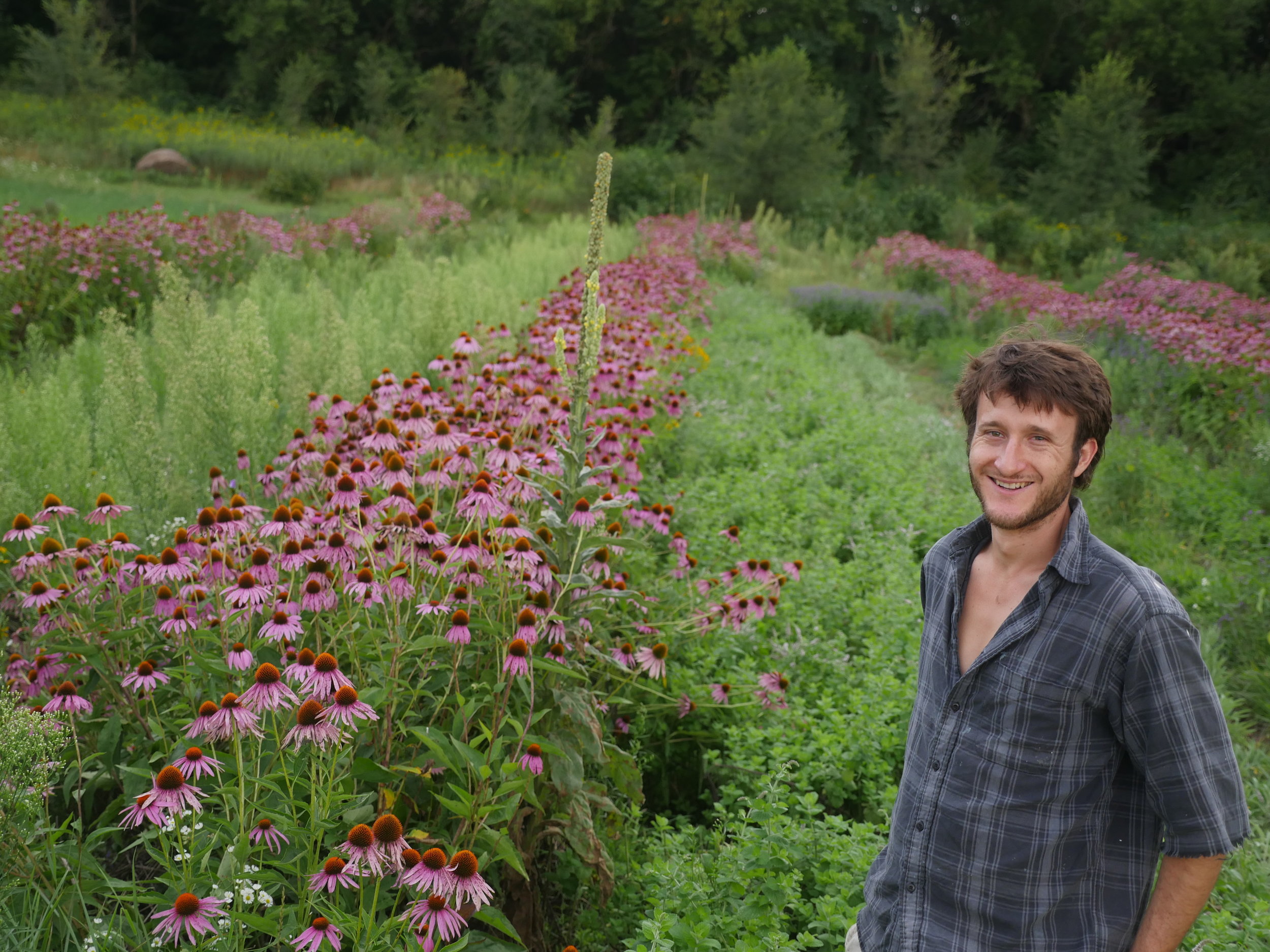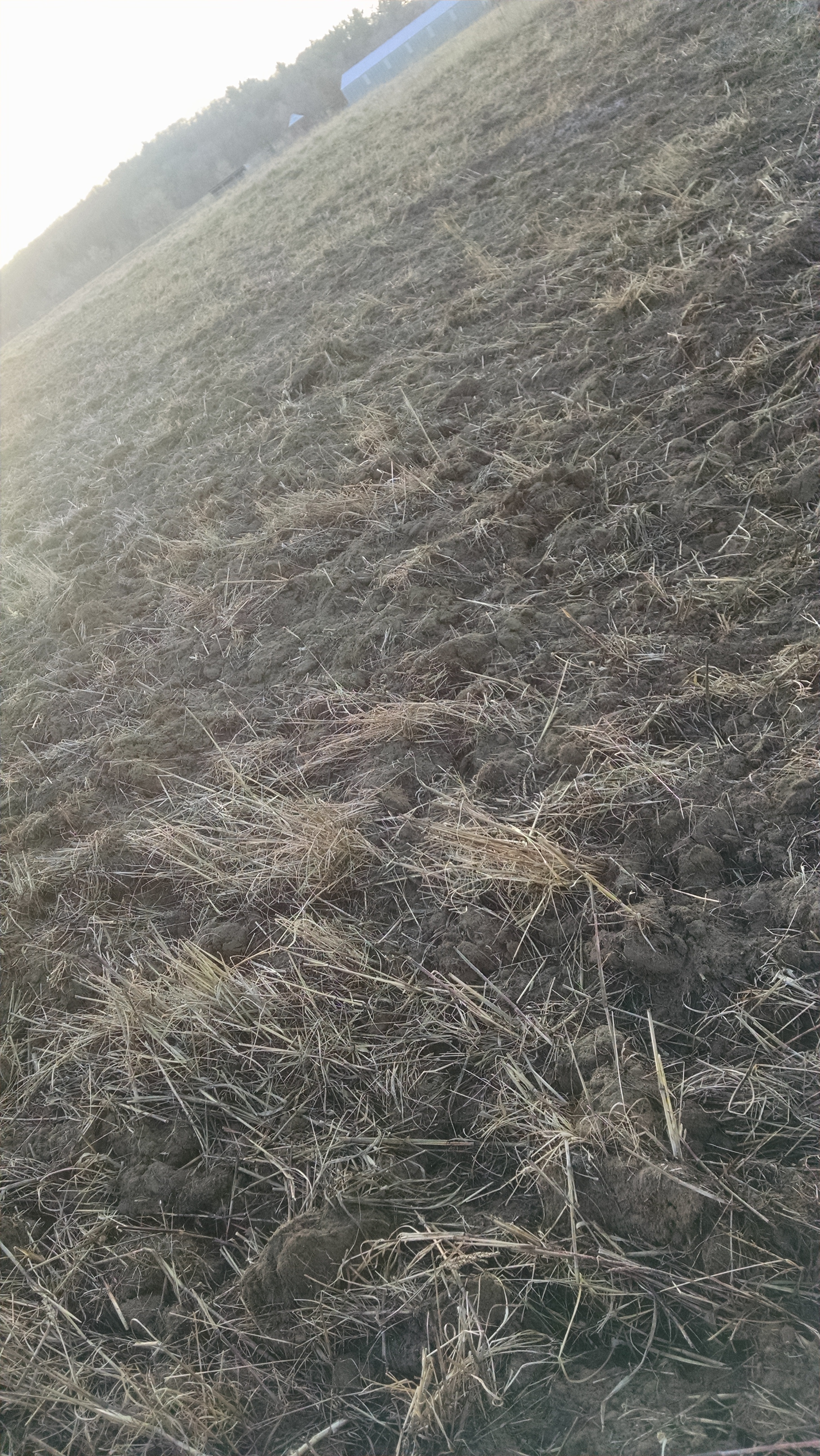In a perennial system winter is not the end, just another step in the cycle and preparing the fields for winter is as important as preparing them for spring. Just like in spring, managing weeds and soil temperature, adding organic matter and enhancing soil life are all main concerns.
I arrived at my farm only two years ago and my primary field can use lots of improvement. I put a 1/4 inch layer of beef manure down followed by a sprinkling of wood chips over most of the acre. It's not enough fertility to grow corn on, but the price was right and I think will be just the right sustained release fertilizer and organic matter the field needs to keep successfully producing high density herbs for another few years. It's not so much about feeding the plants but about feeding the soil. And the layers will also help bury weed seeds.
The whole field received manure and wood chips. This section of fall planted mint and garlic received an extra thick layer.
Grasses and perennial weeds are the bane of perennial herbs. Established perennial weeds will come up better and stronger that your plants in the spring so you better get rid of them now. I hoed ever row taking care to dig as much quack grass root as possible.
I really like mulching perennial herbs; it accomplishes so much. In one step you protect the soil from wind, rain and sun, feed the soil microbes, supply slow release fertility. You keep weed seeds from reaching the light and also keep the soil cooler in the spring which can help inhibit weed germination until the plants are able to shade the soil. I'm about half way through mulching all my perrenail herbs and if the weather cooperates a little longer I will mulch it all.
I try to put on as much mulch as I can without having to come back and uncover the plants in the spring. I don't mind if the plants struggle a little bit in coming up, so long as most of them make it. My planting density is so high that it is okay if the occasional thyme or sage plant dies buried. I actually like burying the true mints so that less stems come up in the spring.
The mulch I use is old moldy straw in big round bales. The disadvantages of these big soggy bales is that they can be hard to work with. Sometimes they unroll nicely and it goes quick but other times I have to scrape the layers of hay off it is too slow really. The mold is a mixed blessing. It is not good to breath so I wear a mask but the conditions that created the mold probably ruined any weed seeds in the straw and the "biologically infused" straw is more quickly useful to the soil. I get the bales almost for free so I am very glad to have them.
Most of the areas where I had annuals are going into red clover. In places where grasses are getting established I am going to till in the spring. There are sections though that were very well tended and the only plants coming up now are winter annuals. I'm not going to till in these spots. Very early in the spring I am going to frost seed the red clover and allow the winter annuals to stay as a nurse crop. Before the winter annuals set seed I will mow them.
Tilling devastates soil life and also brings new weed seeds to the surface. In areas without perennial weed competition I will broadcast red clover seed early in the spring and it will happily come up through last year's crop residue.
Many of my perennial herbs such as apple mint and lemon balm are only marginally tolerant of Wisconsin's cold winters. Strong plants that haven't been over harvested, under irrigated or stressed survive winter much better. A key determinant for overwinter survival is soil temperature and if we have a cold winter with no snow on the ground many plants will die. Covering with a thick layer of mulch helps insulate. I try to find the Goldilocks equilibrium; enough straw mulch to keep the soil warmer over winter and fully protect against weeds in the spring, but little enough so the vigorous herbs can grow through the mulch in the spring without me needing to do any more work.
In a few places there were empty rows among the perennials. I remove the weeds, plant these with garlic then mulch.
My farm is 60 acres but the field in front where I started growing herbs in 2016 is only about 1 1/2. In spring 2017 I started prepping another field. I applied 50 # / acre redmen soil conditioner and 50 # / acre Sea-90 sea solids. Then a neighbor chisel plowed then we disked twice and seeded sudan grass. My main goal was to eliminate perennial grasses and the secondary goal was to increase organic matter. In the flat section of the field the sudan grass grew nine feet and on the sloping area it grew about 6 then we cut it and it grew back 4 feet before frost took it. The treatment did a perfect job of eliminating perennial weeds. We had to empty the barn of manure so we spread that on the field in the fall too then lightly disked. I expect this field will do a wonderful job producing my heavier feeding herbs; true mints, lemon grass, tulsi.
Sudan grass and manure left so much bio-mass on top of the ground that we decided to half disk it into the ground so it could start decomposing. If we were planting by hand it would be different, but in the spring we will be planting with the Japanese paper pot transplanter which requires that there is no residue left in the field.
Finally, in one other section we plowed and disked to prepare for planting oats in early spring.






